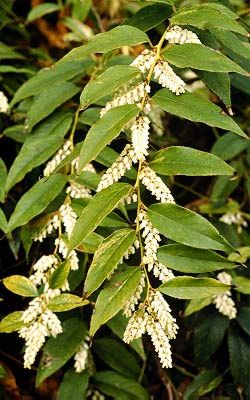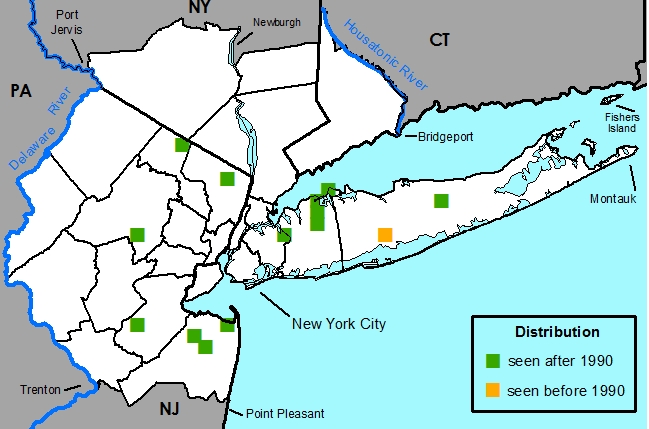Leucothoe fontanesiana (Steud.) Sleumer - Dog-Hobble

Dog-Hobble
Photo © Steven Clemants, 1996, taken at the Brooklyn Botanic Garden.
Common Names
Dog-HobbleField Identification
A spreading shrub with long acuminate, serrate leaves and racemes of white, cylindric flowers.Common names
Dog-Hobble
Drooping Fetter-Bush
Mountain Dog-Laurel
Switch-Ivy
Nomenclature
¤Andromeda serratifolia Gordon & Dermer, A catalogue of trees, shrubs, plants, flowers, roots, seeds, etc. sold by Gordon & Dermer seed nurserymen in Frenchchurch Street, London. 4. [1782?] [cited by (Ludwig, 1783)]. *Andromeda serratifolia C. F. Ludw., Neu. Wilde Baumz. 3, 1783, nom. inval. (Art. 32.1c). TYPE: Type not cited, placed here by (Rehder, 1949).*Andromeda lanceolata W. Young, Cat. Arbr. Amer. 2. 1783, nom. inval. prop (Art. 32.8). *Andromeda lanceolata Desf., Cat. Pl. Hort. Paris, ed. 3, 136 [nom.], 398 [descr.]. 1829, nom. illeg. (Art. 53.1). *Andromeda fontanesiana Steud., Nom., ed. 2, 1: 88. 1841. *Leucothoe fontanesiana (Steud.) Sleumer, Bot. Jahrb. Syst. 78: 438. 1959. TYPE: Cultivated plant at Paris, originally from North America. Desfontaines s.n (?) (Holotype: FI).
*Andromeda axillaris var. longifolia Pursh, Fl. Amer. Sept. 1: 293. 1814. TYPE: United States. Virginia to Georgia, on the mountains. Collector unknown (Holotype: ?). [leaves long, linear-lanceolate]
*Leucothoe catesbaei var. rollisoni Bean, Trees Shrubs British Is. 2: 19. 1915. TYPE: Type not cited.
*Leucothoe catesbaei f. angustata Zabel in Beissn. et al., Handb. Landholzben. 389. 1903, nom. inval. (Art. 32.1c). TYPE: Type not cited.
*Leucothoe editorum Fernald & Schub, Rhodora 50: 218. 1948. *Leucothoe axillaris var. editorum (Fernald & Schub) Ahles, J. Elisha Mitchell Soc. 80: 173. 1964. TYPE: Type not cited, avowed substitute for Leucothoe catesbaei A. Gray, Manual, ed. 2, 252. 1856 (excluding the Leucothoe populifolia material, see below).
Misapplied Names
*Andromeda catesbaei Walter, Fl. Carol. 137. 1788, nom. illeg. (Art. 52.1). *Andromeda walteri Willd., Enumeratio Plant. 1: 453. 1809, nom. illeg. (Art. 52.1). *Lyonia catesbaei (Walter) Gray, Manual, ed. 2, 252. 1856, nom. illeg. (Art. 52.1). *Leucothoe walterii (Willd.) Melvin, Castanea 42: 305. 1977, nom. illeg. (Art. 52.1). TYPE: Location unknown. Walter 572 (Lectotype: BM), selected by (Fernald & Schubert, 1948) [=Leucothoe populifolia].
Nomenclatural Discussion
This plant was long known as Lyonia catesbaei, but the application of the type to his name was in error. "Walter clearly had the mountain species [L. fontanesiana] in mind when he described this taxon, but unfortunately his type specimen was a collection of the taxon that Lamarck had already described as Andromeda axillaris" (Ingram, 1979).
Description
HABIT perennial, evergreen, phanerophyte or chamaephyte, shrubs, autotrophic, monoclinous, with fibrous roots, 0.3-1 m tall, not modified.STEMS erect, round, not winged, "regular". Prickles absent. Not exfoliating. Branches spreading, round, not winged. Twigs dark greenish yellow or light orange or orange or dark orange, not odoriferous, round, 2.5-4 mm in diam., smooth, hairs short and unbranched, erect, unicellular, uniseriate, white, sparse to dense, throughout, not glabrescent, without glands. Pith present, white, round, continuous. Nodal diaphragms absent. Thorns absent. Aerial roots absent. Sap translucent. Resin absent.
LEAVES alternate, 1 per node, spaced ± evenly along stem, divergent from stem, simple. Stipules absent. Leaves petiolate, petiole "typical", 0.6-1.5 cm long, hairs short and unbranched, erect, unicellular, uniseriate, dense, throughout, not glabrescent, without glands. Leaf: abaxial surface light greenish yellow or greenish yellow, adaxial surface yellow, blades lanceolate or ovate, plane, symmetric, 6.7-13 cm long, 2.2-4.7 cm wide, coriaceous, base obtuse or truncate, margin sharply serrate, apex long acuminate, abaxial surface hairs long and unbranched, appressed, multicellular, multiseriate, translucent, sparse, throughout, not glabrescent, glands present, glands at apex of hairs, dark red, adaxial surface glabrous, without glands. Brochidodromous venation, veins 6-11. Leaf lobes absent. Spines absent. Tendrils absent.
INFLORESCENCES monomorphic, regular or, if dimorphic, female inflorescence simple, raceme, axillary. Peduncle absent, Rachis present, 4-7 cm long, with bracts. Bracts sessile, blades: abaxial surface light greenish yellow, adaxial surface light greenish yellow, ovate or widely ovate or very widely ovate, curved, 1.5-2.5 mm long, 1.5-2.5 mm wide, base cordate, margin ciliate (some cilia with apical glands), apex cuspidate, abaxial surface glabrous, without glands, adaxial surface glabrous, without glands. Pedicel 1.7-3 mm long, glabrous or hairs short and unbranched, hairs appressed, multicellular, multiseriate, white, moderately dense, throughout, not glabrescent, glands present, glands at apex of hairs, dark orange-red. Bracteoles 2, sessile, at base of pedicel, not connate, bracteoles: abaxial surface light yellow, bracteole: adaxial surface light yellow, ovate or widely ovate or very widely ovate, curved, 1.5-1.7 mm long, 1 mm wide, base cordate, margin ciliate (some cilia with apical glands), apex cuspidate. Cupules absent.
FLOWERS serotinous, formed on short shoots, monomorphic, with sepals and petals readily distinguishable from one another, bisexual, flowers white, 5-merous, 5.5-7 mm long, 3-4.4 mm wide, 13-27 flowers per inflorescence, fragrance present (?), perianth of two whorls. Calyx present, actinomorphic, campanulate, of fused sepals, persistent, abaxial and adaxial surfaces the same color, light greenish yellow, 1.5-2.4 mm long, 2-3.2 mm wide, tube 0.7 mm long. Sepals or sepal lobes 5, ovate, 1.5-1.9 mm long, 0.7-1.4 mm wide, base obtuse, margin ciliate, apex acute, abaxial surface glabrous, without glands, adaxial surface glabrous, without glands. Epicalyx absent. Corolla present, actinomorphic, urceolate, of fused petals, deciduous, abaxial and adaxial surfaces the same color, white, 5.5-7 mm long, 3-4.4 mm wide, corolla limb 0.5 mm long, 3 mm wide. Petals or petal lobes 5, "normal", shallowly triangular, 0.5 mm long, 1.1 mm wide, base truncate, margin entire, apex obtuse, abaxial surface glabrous, without glands, adaxial surface glabrous, without glands. Gynoecium syncarpous. Carpels 5. Stigmas 1, truncate. Styles not persistent, 1, 3.9-6.2 mm long. Ovary superior, nectiferous disk present. Locules 5. Placentation axile. Androecium obdiplostemonous. Stamens 10, 2-2.3 mm long. Anthers oblong, opening by pores, opening 1/4 of entire anther, bithecal, light orange-yellow, glabrous, Filaments free, straight, white, glabrous. Staminodes absent.
FRUITS loculicidal capsules, dark yellowish orange or dark orange-yellow, depressed subglobose, 2.5-3.2 mm long, 4.5-5 mm wide, glabrous, without glands.
SEEDS many, light orange-yellow or light yellow, deltate, ovoid or oblong, 1.1-1.2 mm long, 0.5-0.8 mm wide, wingless, not tailed, reticulate-foveate or reticulate.
Habitat
Unknown in the New York area; in its native range it inhabits stream edges and thickets.Species Biology
FloweringMay [week 4].
Pollination
Unknown.
Fruiting
May [week 4].
Dispersal
Unknown.
Germination
Unknown.